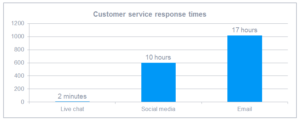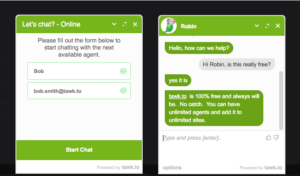What Is Live Chat?
Live Chat, or direct chatting, is a medium that allows businesses to interact with visitors to their website in real-time through messaging. You can use Live Chat to initiate conversations with first-time website visitors, engage with existing customers, and support your current users. It’s a modern, continuous software that’s contextually appropriate for driving higher sales, closing more deals, and retaining customers over the long term.
Live Chat provides a personalized experience for customers, better brand interaction, competitive advantage, and access to customer insights. Deploying a Live Chat solution for your business can be used by marketing, sales, and customer support teams to benefit throughout the customer journey.
Live Chat is an excellent substitute for phone calls or emails. All you or your website visitors need to do is type a message inside the chat box and send it.
Overview of Live Chat
- Founded: January 10, 2002
- Headquarters: Wrocław, Poland
- Developer: Live Chat Software S.A.
- Key Members: Mariusz Cieply (CEO), Urszula Jarzebowska (CFO)
- Operating Systems: Web, Windows, iOS, Android, OS X
- Services: Online chatting, e-commerce, website analytics,…
- Website: https://www.livechat.com
How Does Live Chat Work?
A chat window pops up every time you visit a website. There, you can ask your questions and receive answers and support directly within that messaging window.
Usually, you’ll receive an automatic invitation before being connected to a support agent through some questions like, “Do you need assistance?” or “Hello, how can I help you?”…
When a visitor asks a question, a prompt is quickly sent to the website server to request a response. This response can come from a support agent or an automated reply when website management isn’t present.

Why Should You Use Live Chat?
Maximizing Cost Efficiency
Many businesses opt for traditional support services via phone calls. However, this method is costly both in terms of call charges and labor costs. The cost of using Live Chat isn’t exorbitant compared to professional email services and is much cheaper than phone support. Many studies show that a Live Chat interaction is 17-30% cheaper than a phone call. This is mainly because each phone call can only support one customer, while Live Chat allows for multiple simultaneous conversations, thus saving companies significant personnel costs.

Increasing Profit/Sales Revenue
Live Chat increases conversion rates by 3 – 5 times and delivers an ROI of up to 6000%. Customers using Live Chat are three times more likely to make a purchase than those who don’t use it. These figures highlight the high effectiveness of Live Chat in generating leads and increasing sales revenue for businesses. Because Live Chat provides customers with immediate access to support agents and vice versa, this creates more opportunities to convert these visitors into direct customers.
Enhancing Customer Service and Customer Loyalty
Customers feel more confident when dealing with companies that provide easy, hassle-free, and immediate support services. Live Chat allows you to provide quick answers, resolve issues faster, and reassure customers that you’re always ready to help when needed. This is a simple but highly effective formula for improving customer support and customer loyalty.
Addressing Customer Pain Points
Pain points are the problems or needs that customers are currently facing and haven’t been addressed.
With traditional support systems, such as email or phone calls, it’s sometimes challenging to know the customer’s pain points because they’re only heard or received by another group or individual.
With Live Chat, administrators and supervisors have access to all chat histories; they can be sorted, searched, and filtered to quickly understand the pain points customers are experiencing. As a result, the support department can easily identify customer issues or needs and find ways to address them. This is one of the biggest benefits of Live Chat.
>>> You may be interested in: What Is a Pain Point?
Faster Issue Resolution Support
Documentation and instructional articles are the most common ways to support and assist customers in resolving issues. However, if you have too many documents and instructional articles, customers may find it difficult to search for and use them.

The effectiveness of Live Chat can be seen in the ability of agents to quickly “push” helpful links or documents through the chat window. Therefore, instead of guiding users step by step from finding the appropriate document to resolving the issue, the support team can directly link visitors to relevant documents or content.
With this feature, businesses can save a significant amount of time in addressing issues that customers may encounter.
Enhancing Convenience for Customers
No long waiting times, no cumbersome procedures; simply access the chat window and ask your questions whenever you have any doubts. Live Chat provides many self-service support options that allow businesses to support customers 24/7 even when there’s no direct support from support staff. Therefore, your questions will always be answered immediately without being left hanging.
Live Chat Gives You a Competitive Edge
Live Chat is becoming increasingly popular, and its importance to business operations cannot be denied. However, a recent study showed that out of 1,000 surveyed websites, only 9% of them were using Live Chat.
This means that if you choose to implement Live Chat software on your website(s), you will have an advantage over competitors in terms of instant and friendly support accessibility. You’ll also have more opportunities to actively attract website visitors and generate more revenue, attracting customers ahead of competitors.
Think about this: if you’re a customer trying to decide between two products quickly, would you call or email the support department to get your questions answered, or would you ask directly on the company’s website?!
The positive results that Live Chat brings to businesses have been proven by many studies. If you want to start making a difference compared to your competitors and earn more profit, deploy Live Chat on your websites now.
Expanding Reach to Target Markets
While the internet helps expand your reach beyond your current area, having a website doesn’t mean visitors will feel comfortable placing orders there. However, if your website includes Live Chat functionality, even distant customers can contact you immediately to ask questions or arrange purchases. This includes international customers who may not be able to contact your company via phone due to expensive international calls.
Proactive Engagement
Live Chat allows visitors to access the business’s support department immediately. However, it’s the ability for proactive engagement that truly makes your business website powerful and distinctive.
Instead of waiting for customers to initiate the conversation, you can actively approach the first-time visitors with some questions like “Hello, I’m XXX. Is there anything I can assist you with?” or “Would you like assistance with XXX?”. Such proactive questions will make customers feel welcomed and make the website more user-friendly.
Reporting and Data Analysis in Live Chat
Access to data in Live Chat allows you to view how many visitors your website receives, how many chat requests are accepted or ignored, the performance of these chats, and a variety of other visitor metrics that can help you deploy better marketing strategies to attract more traffic.
Popular Live Chat Software Today
Currently, there are two types of Live Chat available: third-party Live Chat software (or intermediary Live Chat) and Live Chat software coded directly into the website. What are the differences between these two types? Which one should you use to increase conversion rates and effectively support customers? Let’s find out!
Third-Party Live Chat Software
This type of Live Chat integrates third-party software into your website. When a customer visits a website, a chat window will appear. However, to send a message, you need to log in through third-party software like Tawk.to, Messenger, or another popular Live Chat software. The website admin account will not be used to use this Live Chat feature.

For complex platforms like e-commerce sites, only those with website admin rights (not salespeople on the platform) can interact with customers through Live Chat.
If you want to use this type of software, you only need to request that the website design team integrate it into your website, then create an account, and you’re good to go.
Third-party Live Chat software is widely used because it saves costs, and most of these software options are provided for free with all the necessary features.
When using this type of software, you will be provided with a dashboard to monitor all responses, messages, and customer activities, even being able to send or receive files directly within the chat window.
If your budget is limited, intermediary Live Chat software is a perfect choice. A free version is sufficient for you to improve user experience and customer care on your website.
Website-Coded Live Chat Software
In contrast to intermediary Live Chat software, with website-coded Live Chat software, you don’t need to log in to any other platform to respond to or ask questions, but rather interact directly with customers or support staff through the website.
Because it’s designed specifically for the website, website-coded Live Chat has all the features you need. You can manage everything from received/sent files, information, exchanged messages with customers… in the website’s control panel. However, website-coded Live Chat may not be suitable for all businesses due to its high cost and extremely complex design process, requiring experienced and highly skilled programmers.
Things to Note When Using Live Chat
Empathy
Always put yourself in the customer’s shoes. If they complain or are disappointed because there’s an issue with the website or an item they want to purchase is out of stock, don’t act annoyed or ignore the customer. Try to understand the problem and find ways to address it.
Use Positive Language
When responding to customers, avoid using negative words like “no,” “don’t have,” “don’t know.” For example, when a customer is looking for a product that’s out of stock, instead of saying “we don’t have this product and won’t have it available for the next 2 weeks until the next shipment,” say “this product will be available within 2 weeks. I can pre-order it for you and ensure it will be shipped as soon as possible when it’s in stock.”
Mastering the art of speaking positively takes time. Provide relevant training programs for your staff and encourage them to review their answers before sending them, not only to identify spelling errors but also to ensure that the language used is appropriate and positive.
If Uncertain, Ask the Customer
Live Chat is an interaction between people. Therefore, not understanding a customer’s question is understandable. If this happens, instead of avoiding it, ask questions to clarify what the customer is asking or what they want. This can prevent bigger issues later when they don’t get what they want or expect.
Don’t Handle Too Many Chats at Once
Although the ability to support multiple customers at once is Live Chat’s outstanding strength compared to other support tools, after a certain chat, the level of service provided to customers will decrease, and the likelihood of errors by staff will increase.
The general rule is to handle a maximum of 5 chats at a time. However, the complexity of each chat, the speed of customer responses, and the skill level of the staff will all affect the quantity and quality of each chat. Therefore, always balance. Don’t sacrifice quality for quantity.
Honesty
If you need time to research something, let the customer know. Don’t leave them waiting without knowing what’s going on.
While customers may not want to wait for a response, they will feel much more positive about an issue if the company takes the time to understand it.
Avoid Ending Conversations Too Early
Before ending a conversation with a customer, always ensure two things are achieved when using Live Chat:
- The customer is satisfied with the outcome.
- The customer has no further questions.
Employees may always want to end conversations as quickly as possible, but that’s a big mistake. If customers feel their queries are not adequately addressed, they won’t be satisfied.
The Difference Between Live Chat and Chatbot
Currently, there is still quite a bit of confusion between the two concepts of Live Chat and Chatbot. So what is the difference between these two forms? Let’s find out:

Similarities:
Live Chat and Chatbot are both created to optimize interaction with customers quickly and conveniently. Both are developed based on website platforms, dialogues, and messaging applications.
Differences:
| STT | Live Chat | Chatbot |
|---|---|---|
| 1 | The interaction is conducted between human beings. Live Chat enables businesses to respond contextually while sensing the emotions of customers. | The interaction is conducted between a human and a machine through a predetermined list of questions and programmed answers. |
| 2 | If Live Chat does not provide the capability to track customer information, offering personalized services will be a significant challenge. | Modern chatbots have the ability to integrate conversation data with the visitor’s profile, enabling you to customize the entire customer experience. |
| 3 | Live Chat has the capability to handle complex queries from customers, especially when the queries involve difficult technical terms or specialized jargon. | New AI-driven bots can be trained to handle complex queries. However, most companies are still stuck with command-based chatbots, followed by more advanced AI-driven chatbots. |
| 4 | Because humans (employees, website administrators) are directly involved in this process, there may be several limitations when handling multiple conversations simultaneously. | A chatbot can handle any number of conversations as long as the programmed list of questions can be answered and supported by AI mechanisms. |
| 5 | Live Chat is not useful when faced with numerous general, common, and repetitive queries. | Chatbots are particularly useful when the nature of customer requests is simple and repetitive. |
Conclusion
Above is a summary of the most basic knowledge about Live Chat that you should know. From the definition of Live Chat, how it works, the benefits it brings, to the considerations when using Live Chat to achieve the best effectiveness for your website.
Live Chat is software that brings many benefits and increasingly asserts its important role in the business operations of companies in general and websites in particular. Depending on the budget and goals of the business, choose the type of Live Chat that suits you. Understand the differences between these two popular Live Chat types to avoid unnecessary risks in the design and use of Live Chat. Hopefully, this article has helped you understand many important issues surrounding the question of what Live Chat is and how to apply this useful information intelligently.







